
Acorn Street
Great Street to take pictures
Acorn Street is widely cited as the "most-photographed street in Boston" is the perfect street to start this month-long Boston Photographic series. All month long we'll look at where to take the best pictures of the city of Boston.
This street is famous because it is the last remaining street in Boston, to be fully lined up with cobblestones. It's also unique because it's a single lane street and has a downward slope.
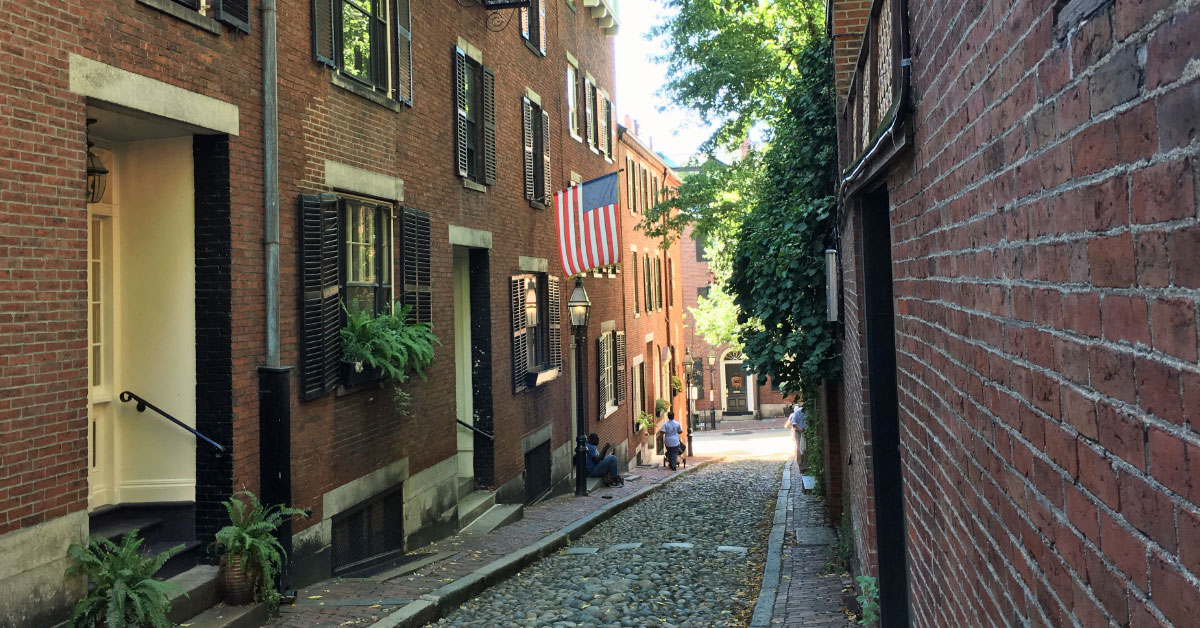
Make sure you make good use of depth of field here!
Tips on Taking the Best Pictures
This is a popular location and you'll most likely encounter other people visiting this location to take pictures. Be patient and wait for the right moment to take your prize shot.
I have found that the top of the street has fewer people than the bottom of the street. The top of the street is the best place to take the picture. You get the best depth of field.
The best time to come here is in the late afternoon as the sun starts setting.
If you have a DSLR, this is a great place to try different lenses to see how a lens can really change the view.
The Gas Lamp and American Flag is a great "colonial-type" close-up picture to take. Rarely will you see a flag near the gas lamps.
The street is not plowed during the winter, so the street doesn't have the same old time look.
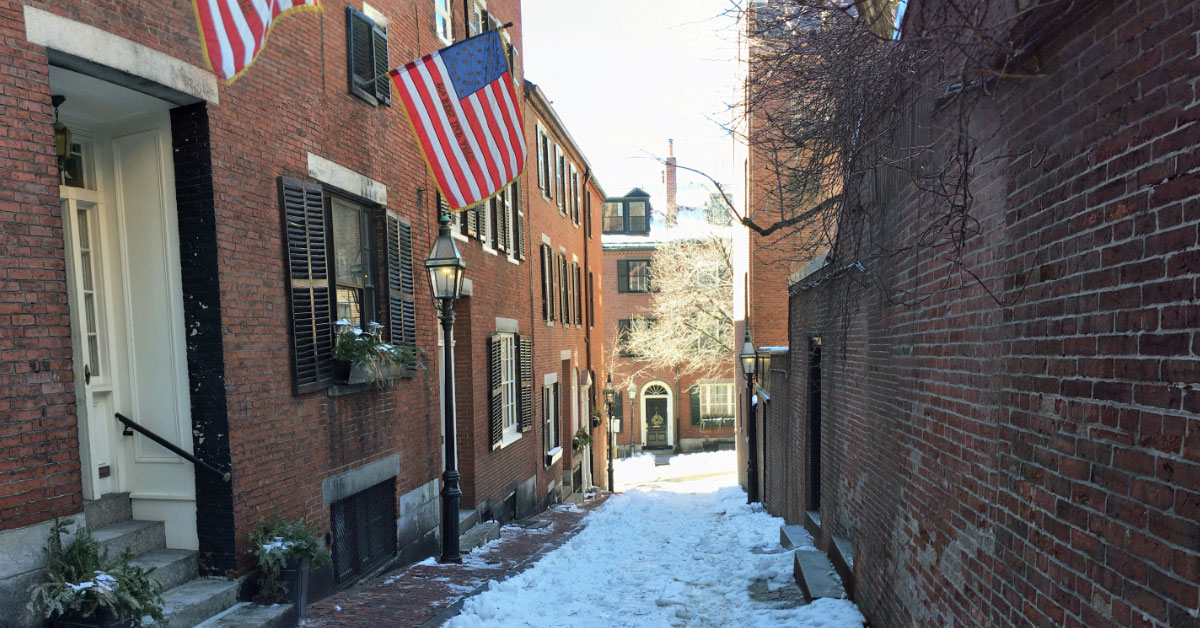
While it looks pretty in the winter, without the cobblestones it's just another street.
Finding Acorn Street
Acorn Street is far away from any T stop, the closest stop would be Boylston Street. It's a 10-minute walk from the train station.
From Boylston Street, walk down Charles Street - the street between the Commons and Gardens. Cross the street at the Intersection of Charles and Beacon Street. Walk two blocks to Chestnut Street and take a right. Walk two blocks to W. Cedar St and take a left. Acorn Street will be the next street.
You'll be at the bottom of the street, walk up the cobblestones to the top of the street for your picture perfect opportunity.
PermalinkLouisburg Square
General information about Boston Louisburg Square
Louisburg Square is a small square located in the Beacon Hill area of Boston Massachusetts.
Most people may have heard about the square from the children's classical book - Make Way for Ducklings by Robert McCloskey
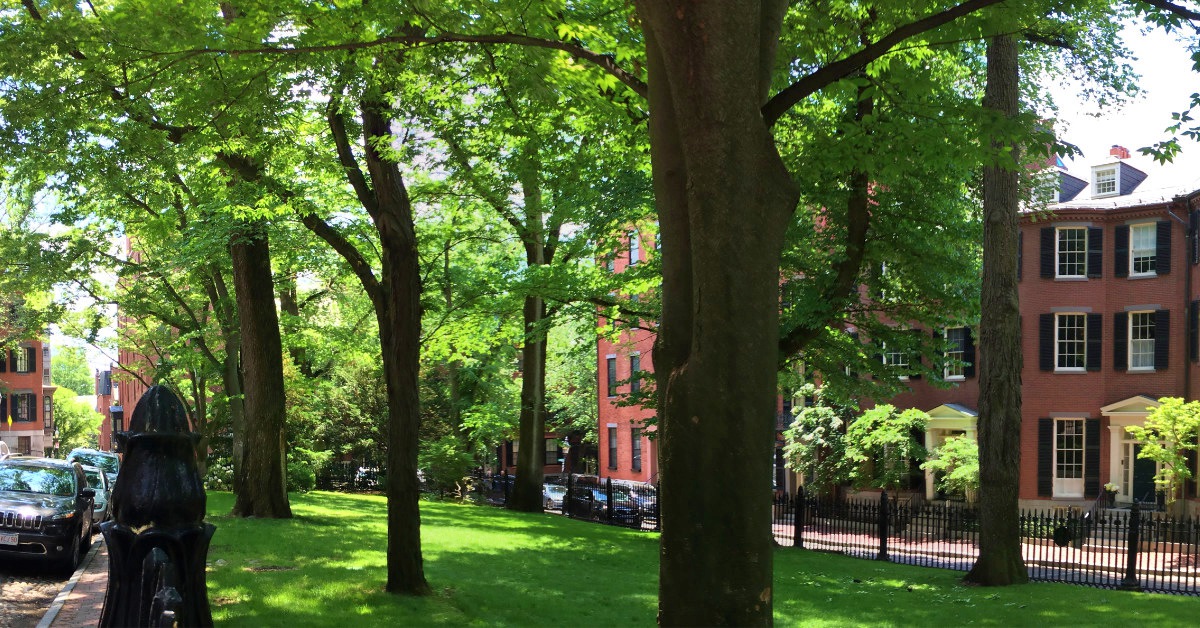
Five Interesting Houses Around in the Square
- 10 Louisburg Square is where the Alcotts lived for a few years in the 1880s.
- 19 Louisburg Square is the oldest house on the street built in 1834
- 20 Louisburg Square is where Jenny Lind married her accompanist Otto Goldschmidt.
- 3 Louisburg Square townhouse sold in 2012 for $11 million. It was the 2nd biggest deal in Boston. 15 Commonwealth Ave was the biggest at 12.5 millon
- 85 Pinckney Street was on the market in 2017 for $14,950,000 or $2,136 a square foot
Fun Facts About the Louisburg Square
- Charles Bullfinch came up with the idea for the square in 1826. The square was built up around the same time the current State House was being constructed.
- Louisburg Square is named after the battle of Louisburg, during which the Massachusetts Militiamen sacked the French Fortress in 1745.
- The houses surrounding the square were built between 1834 and 1848 on small plots suitable for row houses.
- The small park is privately owned by all the houses that have visibility to the square. This is the first privately owned park in the nation. Only house owners have keys to the gate.
- The Proprietors of Louisburg Square was formed in 1844 as the entity responsible for maintaining the square.
- The only other privately own square is the Gramercy Park in New York City
- There is an iron fence around the square and only residences are allowed in the square.
- On the road around the square you can see the original cobblestones that were placed in the 1830s.
- There is a statue of Columbus at the north end and of Aristides at the south end (closest end to the Boston Public Gardens).
Seal of Boston at the Boston Public Gardens
Did you ever notice the picture on the Seal of Boston?
There is a gate entrance to the Boston Public Gardens. It's used to open and close the gardens after dusk.
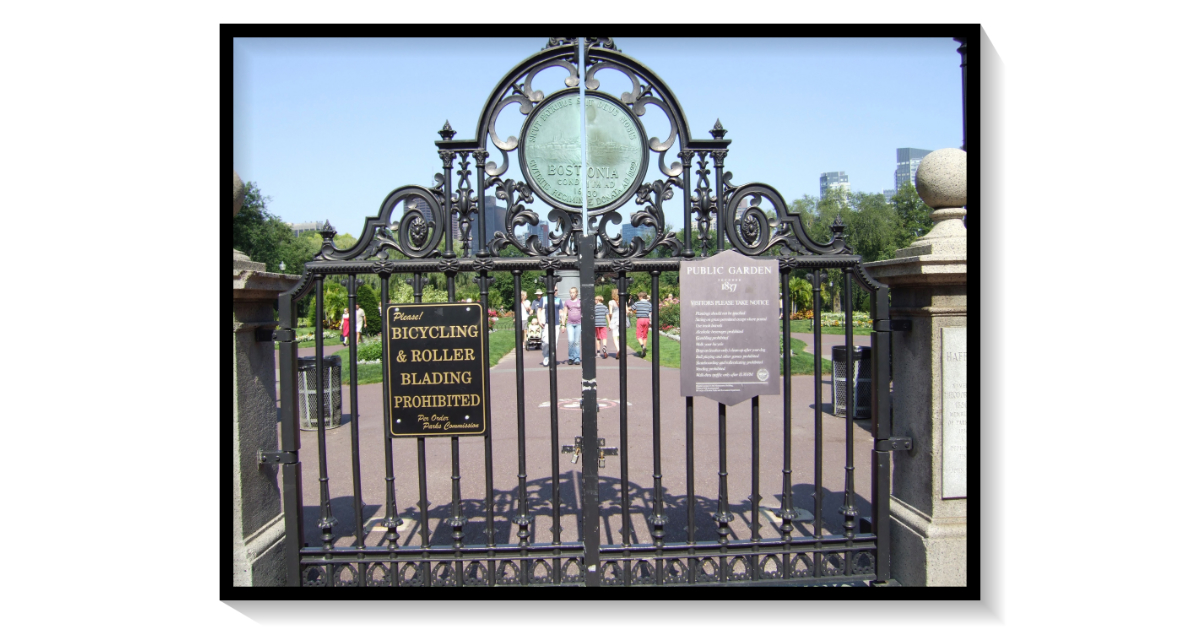
Look carefully at the Center Gate
There is a little secret to the top of the gate.
Above the gate entrance is a small oval which contains a picture what the town of Boston looked like in 1823. This is the official seal of the City of Boston
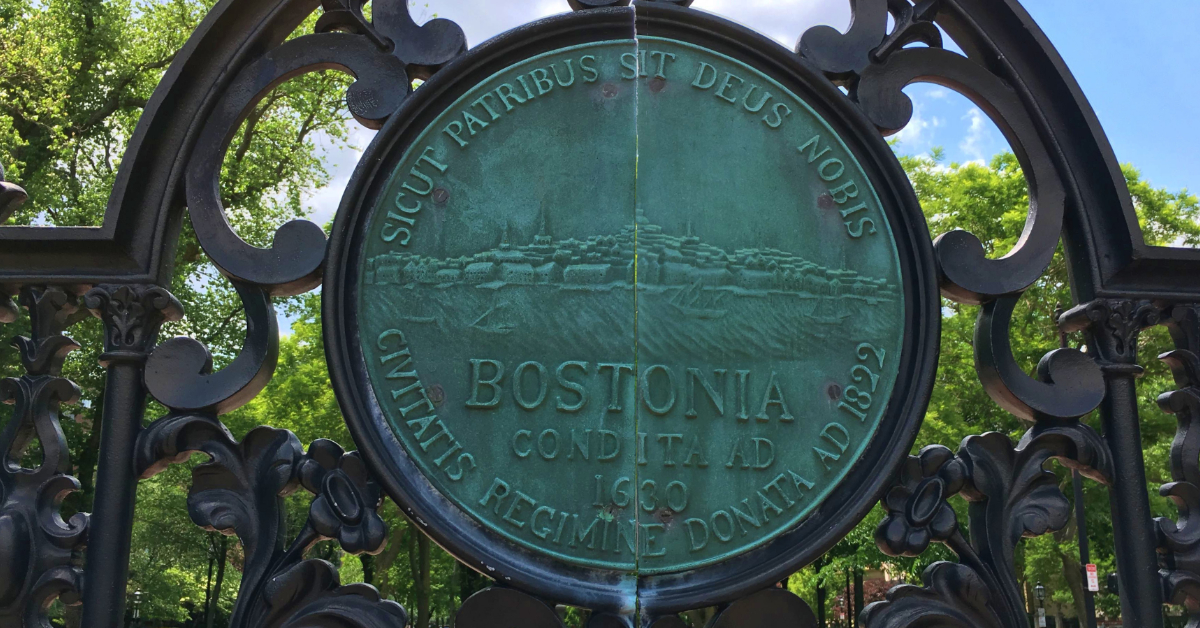
Six Fun Facts About the Seal and Gate
- The map on the official Seal of Boston is significant at this location because the Boston Public Gardens didn't exist on the map. It was marshland and flats known as Roxbury Flats. The Boston Public Gardens was known as the Botanic Gardens started in 1839 but didn't get fully accepted by the citizens of the town until 1859.
- The City Seal was adopted in 1823.
- The current gate was built around the Boston Public Gardens as part of the park restoration project in July 1974. The budget for fixing and protecting the Boston Public Gardens in 1974 was $1.65 million.
- "SICUT PATRIBUS SIT DEUS NOBIS" is Latin phrase from the Bible - "God be with us as he was with our fathers" ' (1 King's, viii, 57).
- "Bostonia Condita AD 1630" is Latin meaning Boston was founded in 1630.
- "Civitatis Regimine Donata A.D. 1822" is Latin meaning the city was incorporated in 1822.
- Therefore, Boston was founded as a town in 1630 and incorporated as a city in 1822.
Christian Science Center Plaza Update
Lots of Construction going on, good things to come!
In case you haven't noticed, the Christian Science Center Plaza has been going through a major update. In 2018, most of the plaza has been closed. This is to help modernize the plaza and make it more welcome for people to come and visit.
Full details on the construction can be found on the Christian Science Center Plaza Construction Page.
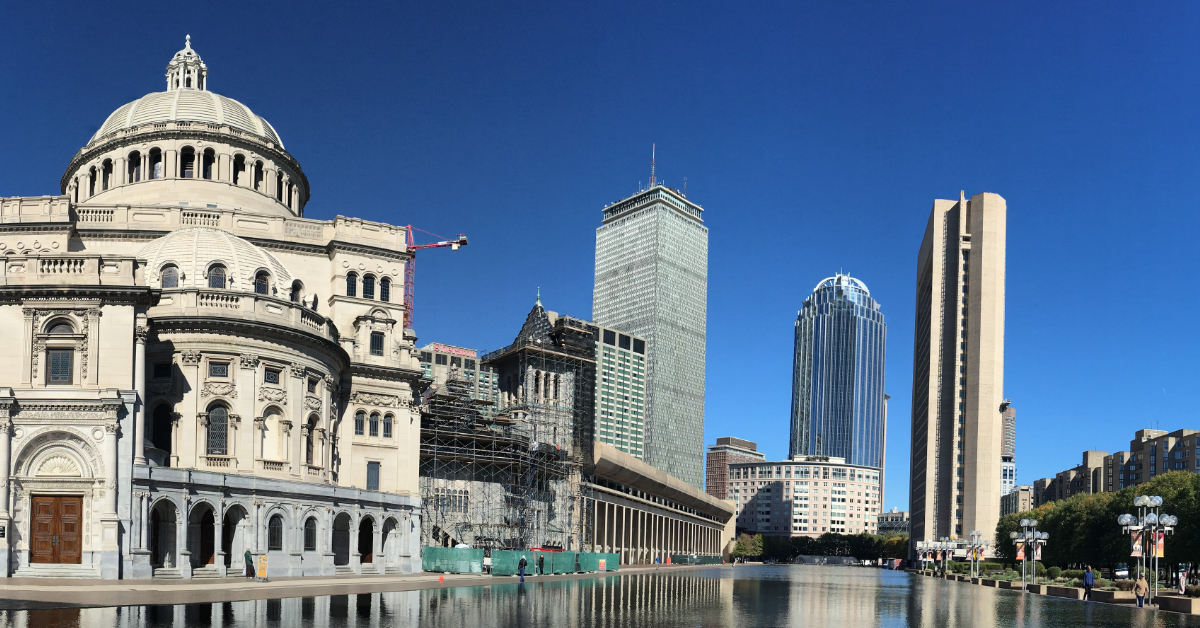
For the most part, this view will not change at the competion of the construction.
Construction End Date
According to the Project team the project is on schedule and should be completed by this Fall.
What's Changing on the Plaza
The most noticeable change is to the reflection pool:
- It's now going to be shallower so that it uses less water.
- The pool will look better when there is no water in it. There are dark stones on the bottom of the pool. (Currently it looks like they are solar panels - they are not.)
- It's going to be slightly shorter to provide easier access to the plaza from Huntington Ave.
Mother Church is closed and worshipers are asked to attend services in The Mother Church Extension - which is the building connected to the Mother Church.
There is construction going on by the Massachusetts Ave side of the plaza to increase the green space in front of the church.
The popular Children's Fountain is still open and running during the final phases of the construction. There are no major changes being done in this part of the plaza
Ultimate Goal
When completed, the plaza will be more picturesque any time of the year. For example: taking pictures of the Christian Science Center Plaza from the Prudential Skywalk Observatory will look much better.
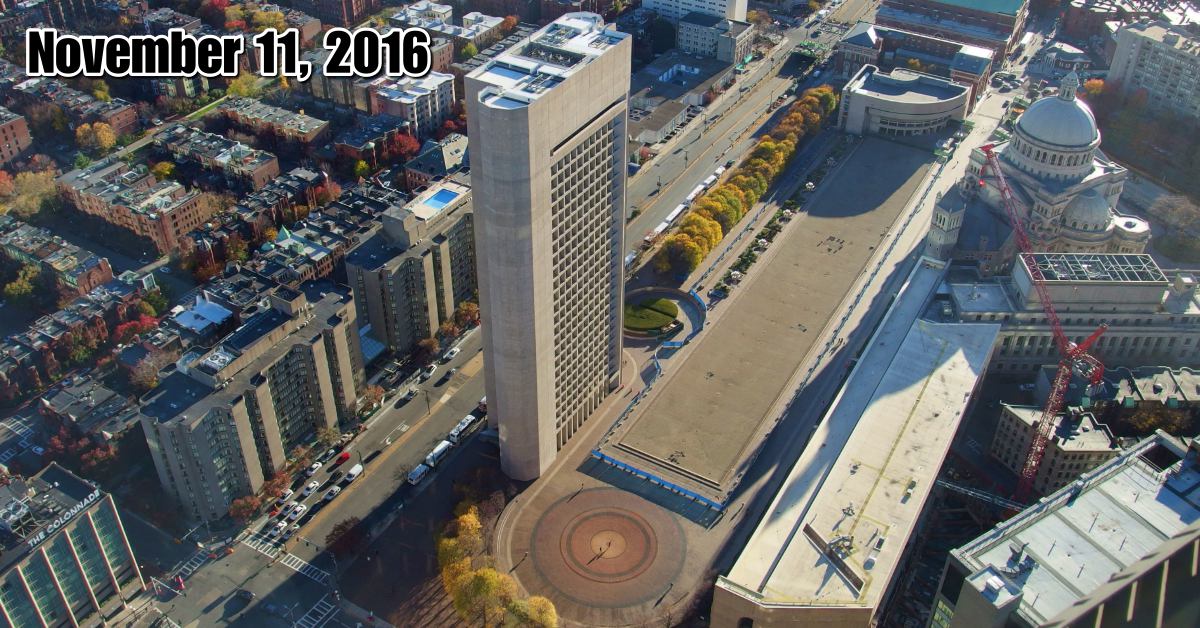
First Independence Day Toast
The first Toast to America in 1777
The first Independence Day in Boston was a very special event. People were celebrating and fireworks going off all over the city. The guns were going off at Castle Island and at Fort Hill to celebrate the occasion.
At a Coffee Shop in Boston, perhaps the Green Dragon Tavern, thirteen people from various states gathered and each one shouted out a toast. Each person would have a drink and one by one they gave a special toast.
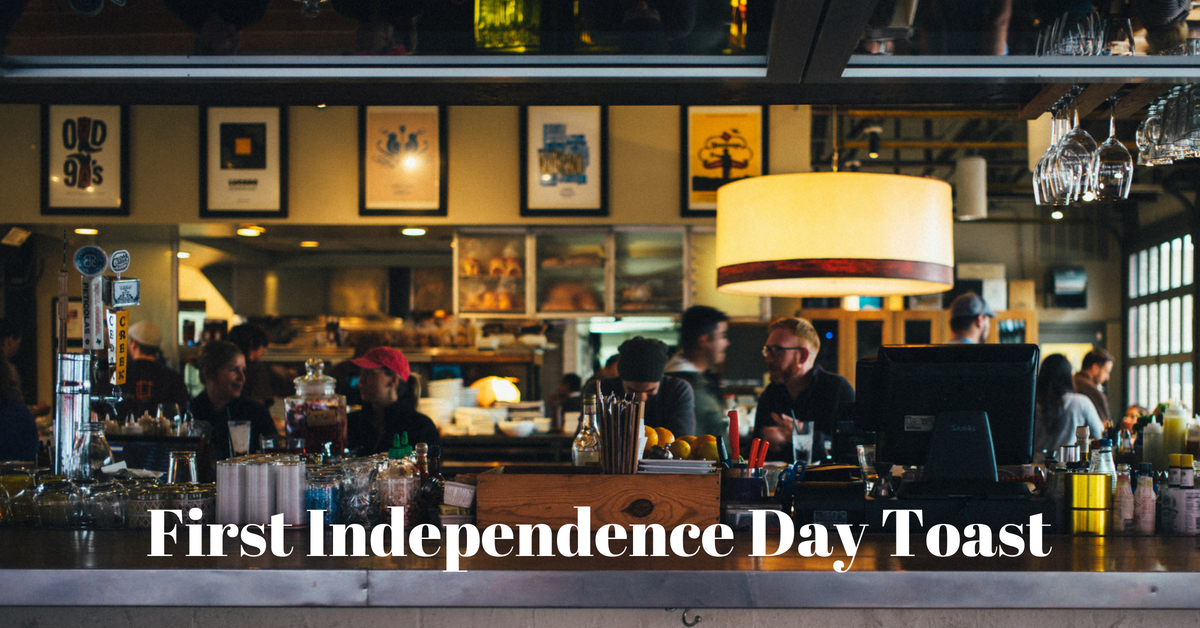
Toast to Independence Day
Here are the thirteen toast given at the very first Independence Day in Boston:
- The noble and honorable Representative of the United States in Congress, who voted the same free and independent. (Cheers!)
- May the Lord God protect the United States, now and henceforth, forevermore. (Cheers!)
- The United States of America and may the good people of the same support their independency. (Cheers!)
- The President of the Grand Continental Congress and the present members of the same (Cheers!)
- Our Noble and worthy General Washington and the Army (Cheers!)
- Success to the American Navy (Cheers!)
- May the Fourteenth string be added to the harp (Cheers!)
- May the Army of America vanquish the enemies of American independence. (Cheers!)
- Many none but men of honor and virtue test American freedom (Cheers!)
- Liberty to those who have the virtue to defend it. (Cheers!)
- May the union of American states be as lasting as the pillars of human nature (Cheers!)
- Major General Charles Lee and all our friends in captivity (Cheers!)
- The immortal memory of General Warren all al the rest of our brave officers who have been slain since the commencement of this unnatural war. (Cheers!) (Cheers!)<
After the thirteen general toast was given, a special toast was given to each of the thirteen states.
Source: Boston Globe and various history books.
PermalinkGerrymandering
Gerrymandering term originated in Boston
"Gerrymandering" is a term used to describe a political practice of drawing district boundaries in an unnatural way to favor a political party chance of winning that district.
This term came about in Massachusetts in 1812 - when the Governor created a new district to help the Republican-controlled legislature stay in power. The weird shape district looked very weird and many people thought it looked like a salamander.
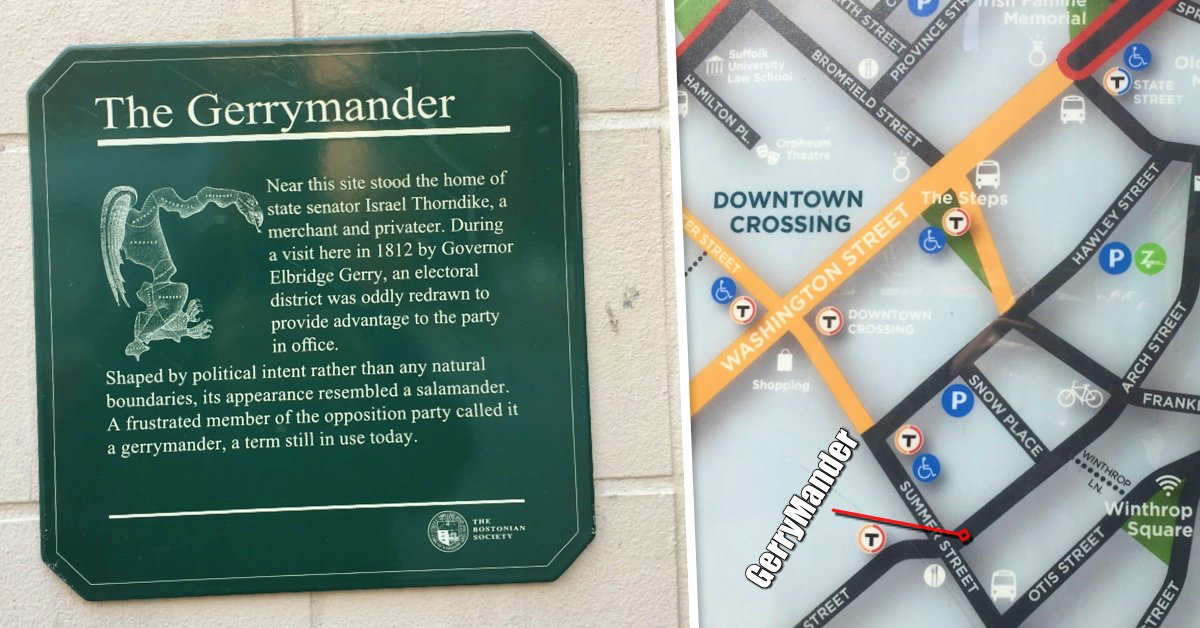
Five Facts about GerryMander
- The word gerrymander was used for the first time in the Boston Gazette on 26 March 1812 in reaction to a redrawing of Massachusetts state senate election districts under the then-governor Elbridge Gerry (1744-1814)
- The term was originally written as "Gerry-mander"
- Elbridge Gerry, was one of the signers of the Declaration of Independence. He is the only signer of the Declaration buried in the nation's capital.
- Elbridge Gerry was the Vice President under President James Madison.
- Elbridge Gerry was one of three people that refused to sign the U.S. Constitution at the Constitutional Convention (Edmund Randolph and George Mason of Virginia were the other two. Elbridge Gerry wanted more individual liberties in the constitution.
- The earliest occurrence of Gerrymander was the districting of New York State Orange County to help Monroe over Madison on February 2, 1789. Madison ended up winning the County.
Gerrymander Sign
Near this site stood the home of state senator Isreal Thorndike, a merchant and privateer. During a visit here in 1812 by Governor Elbridge Gerry, an electoral district was oddly redrawn to provide an advantage to the party in office.
Shaped by political intent rather than any natural boundaries its appearance resembled a salamander. A frustrated member of the opposition party called it a gerrymander, a term still in use today.
The word gerrymander (originally written "Gerry-mander") was used for the first time in the Boston Gazette on 26 March 1812 in reaction to a redrawing of Massachusetts state senate election districts under the then-governor Elbridge Gerry (1744-1814)
Finding the Sign
The sign is located on a red/white building near Downtown Crossing. As you enter Arch Street from Summer Street if you look to your right you will see UDG restaurant. If you follow along the wall you will see the green sign against the white wall.
PermalinkWicked Cool WiFi
Did you know the Boston Public Gardens has Free Wifi?
Did you know that there are various free WiFi spots around the City of Boston? Two of the most popular tourist spots are also Boston's hottest spot to do work - Boston Commons and Boston Gardens.
In 2016, The City of Boston installed free wireless access points in the Boston Public Gardens and the Public Commons. Making these a great location for laptop users to go offsite and get work done in a nice relaxed atmosphere.
The "Wicked Free Wi-Fi" map has location points to where the access points are, but just about anyplace in the Gardens/Park has Wifi access. Just make sure your laptop is charged, as there is no place to plug-in.
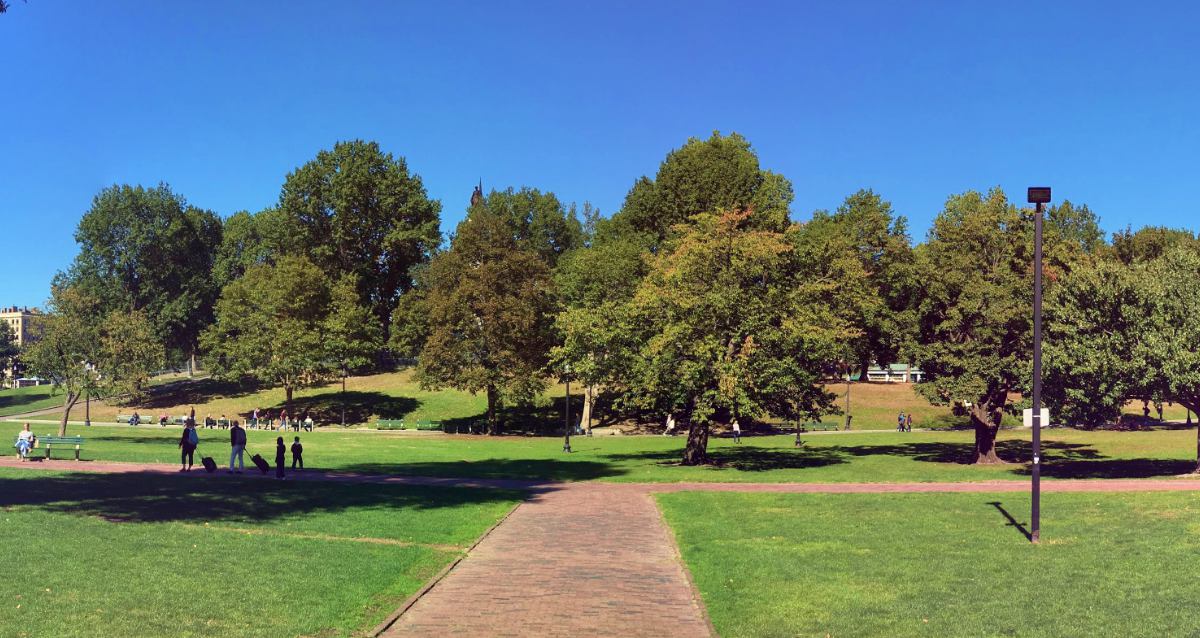
Additional Free WiFi Spots
There are a couple of other Wi-Fi spots around the city that make for a great escape from the office or if the office WiFi is not working correctly. If your visiting Boston, these Wifi spots are great if you want to upload photos from your phone.
Boston Public Library at Copley Square
Grab a desk and get some work done at the Boston Public Library. Is it Performance Review times? Need some getaway time from all the constant interruptions? This is the place to go. Plenty of tables and comfortable places to charge up the laptop.
The two quietest places in the Library is the Kristen Science Center and Bates Hall. Bates Hall is really an inspirational place to work - very cool architecture. However, when someone moves a chair, it can echo and be a distraction. Kristen Science Center has lots of desk with USB and plugs. The chairs are more comfortable than Bates Hall.
Prudential Center Mall
The Prudential Center Mall has free WiFi for shoppers and visitors. You can even get WiFi access in the courtyard - which is very convenient if you work in one of the office buildings in the complex.
Wifi is also available at the Starbucks inside the Barnes and Noble. Get a Venti drink and a snack and work away!
There were a couple of times where the Prudential Center Mall Wifi came in handy when the power went out in the office.
Any Other Spots?
If you work in Boston, are there any other wifi spots worth sharing? Any places that might be inspiring to check out?
PermalinkLouisa May Alcott House
House on 20 Pinckney Street was once occupied by the Alcott
Many people have heard about the Alcott's Orchard House in Concord, Massachusetts. Did you know that the Alcott's moved around a lot? For many years the family lived in Boston.
If your walking around Beacon Hill you may encounter a sign on a house that Louisa May Alcott once lived at:
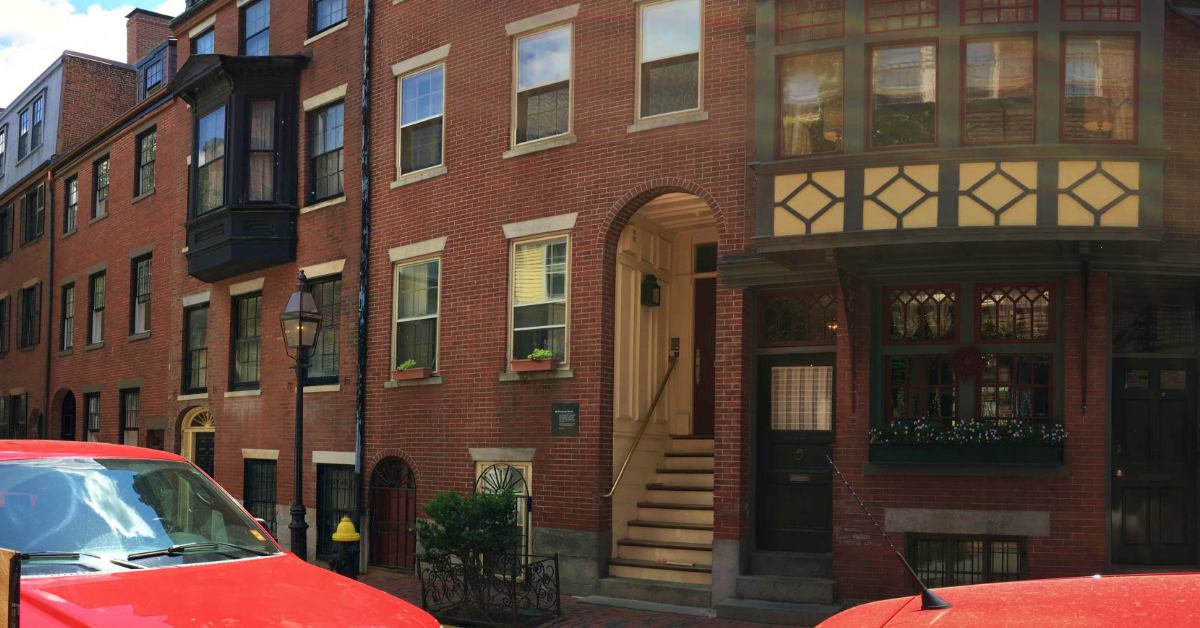
Fun Facts about the Boston House
- Louisa May Alcott and her Father lived here from 1852 to 1855 (She was 20-years-old)
- She wrote her first story here: The Rival Painters: A Tale of Rome
- Louisa May's room was on the third floor
- Thanks to the success of Little Women, the Alcotts was able to move to the more prosperous neighborhood of Louisburg Square.
- The house is part of the Boston Women's Heritage Trail of Beacon Hill.
Plaque on the Building
The plaque on the building reads:
As a little girl Louisa May Alcott lived in rented rooms at 20 Pinckney Street. The Alcott house was part of the Boston literary scene during the decades before the Civil War. Louisa's father Bronson Alcott, was an innovative educator whose friends included Ralph Waldo Emerson, William Henry Channing and William Lloyd Garrison.
In the 1800s, her reputation and fortune secure, Miss Alcott returned to Beacon Hill. She lived at 10 Louisburg Square until her death.
Finding the Boston's House
The house is located at 20 Pinckney St, Boston, Massachusetts. This is a private residence, there are no tours in this location.
Best Public Transportation Route: From Park Street Station, walk up to the State House, turn left on Beacon Street, and then right onto Joy Street then take your second left onto Pinckney Street. The house will be the eighth house on your left.
PermalinkWall of Literary Awards
Interesting Wall of Literary Awards at the Boston Public Library
While Hollywood has the "Walk of Fame", to celebrate the Stars. Boston has the Wall of Literary Awards Wall to celebrate the accomplishments of local literary writers.
In Copley Square, at the Boston Public Library, is a wall of Massachusetts literary writers that have won distinguished awards in literature.
The Literary Wall concept was created as part of the major library redesigned that was completed in 2017.
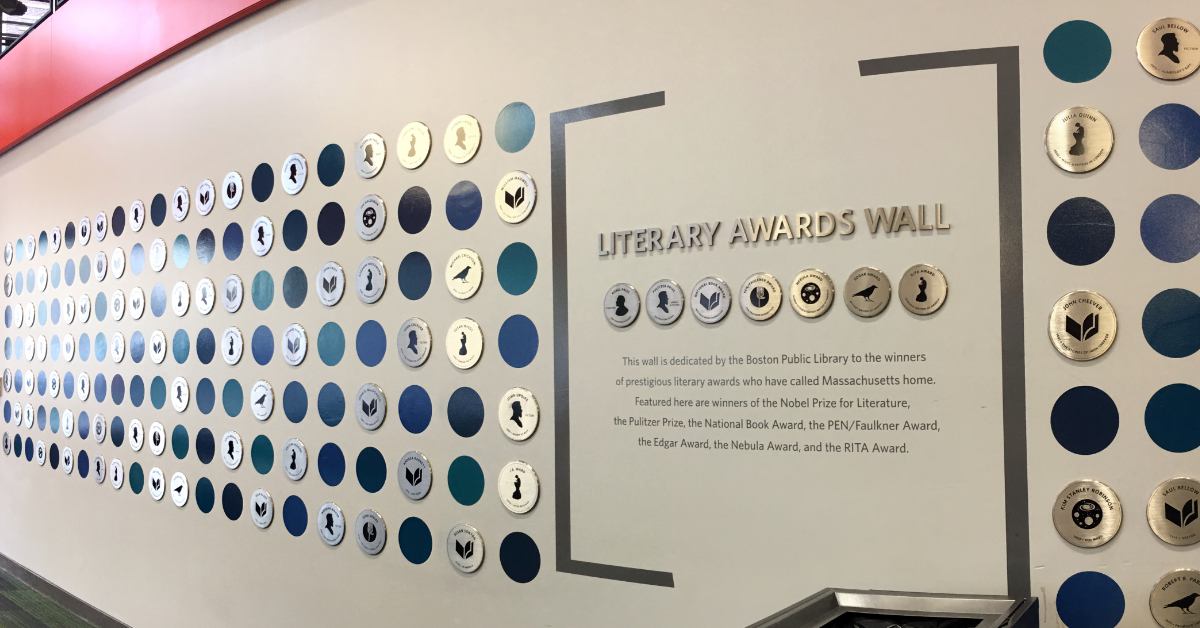
Qualifying Awards
- Noble Prize for Literature - The Swedish Academy
- Pulitzer Prize - The Pulitzer Prizes
- National Book Award - National Book Foundation
- Pen/Faulkner Award - Pen/Faulkner Foundation
- Nebula Award - Science Fiction & Fantasy Writers of America
- Edgar Award - Mystery Writers of America
- Rita Award - Romance Writers of America
Missing Authors
While there are many distinguished authors on the wall - Edgar Allen Poe makes several appearances. There are a number of authors that are not on the wall, simply because they haven't won any of the major awards. (At least their work existed long before the awards were ever handed out)
- Louisa May Alcott
- Ralph Waldo Emerson
- Henry David Thoreau
- Nathaniel Hawthorne
- Dr. Seuss
- Elizabeth Palmer Peabody
Finding the Wall of Literary Awards
The Wall of Literary is located on the first floor of the Main Library. It's located between the Fiction section and the Cafe.
Enter the library from Boylston Street, and head over to the Cafe. Take a left before the Cafe and you'll be in the Fiction area of the Library. Walk a few steps into the Fiction area towards the staircase, and then look back towards the Cafe and you'll see the Wall.
PermalinkMarvin Goody Memorial
Interesting facts about the Marvin Goody Memorial in the Public Gardens
In the Boston Public Gardens, along Charles Street, is a flagpole and several granite benches. This is a memorial to Marvin Goody.
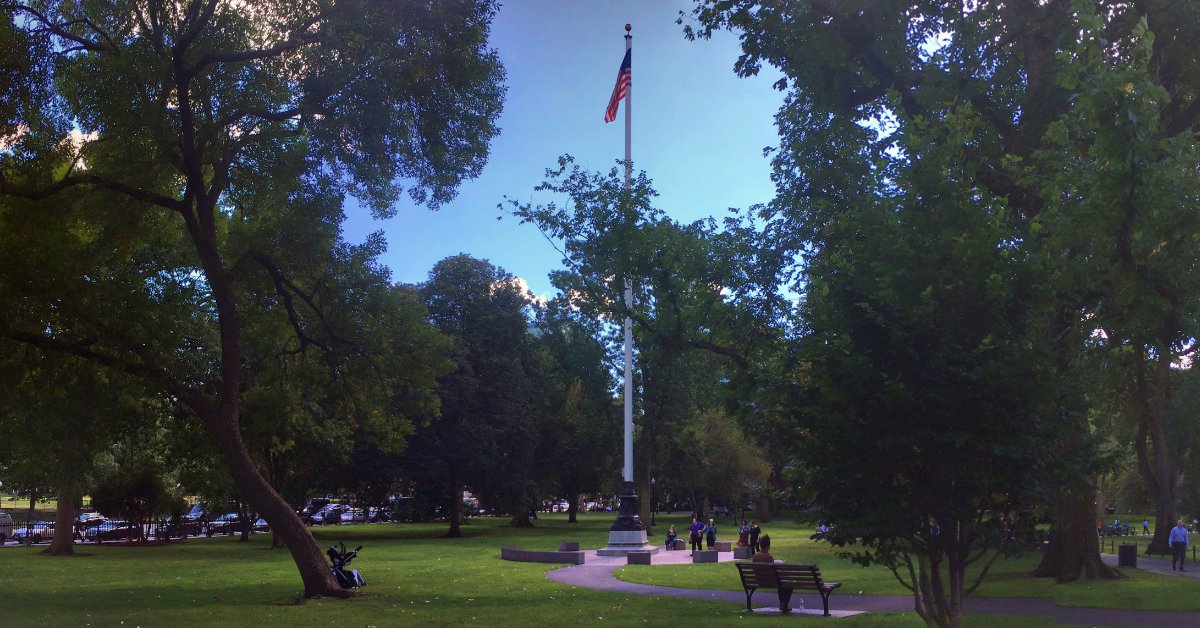
Who Was Marvin Goody?
This memorial is in honor of Marvin Goody, who was a former chairman of the Boston Art Commission and Friend of the Public Garden and Common, as well as an MIT faculty member.
Interesting Facts about this Memorial and Marvin Goody
- Born in 1929 and died of a heart attack in 1980.
- He was a well known and respected architect and worked at Goody Clancy
- He was one of the founders of the Friends of the Public Garden
- His Wife, Joan Goody, designed the circle memorial where the couple once walked each morning to their office to near-by Boylston Street.
- The memorial was partly funded by the Edward Ingersoll Browne Trust Fund
- The memorial is a circular arrangement of square stone block benches around a flagpole. (The benches are called "Pods")
- He worked hard to keep up the Public Gardens, which is why there's a quote at the memorial which reads, "To See His Work, Look Around You"
- There is a sycamore tree that was planted near the memorial in his memory.
- He founded the red stones used on the Public Gardens bridge
- He made sure that the fountains were working order and frequently checked them to make sure that water was always flowing.
- A $5,000 annual prize in Goody's name was set up in 1983 for architecture, city planning or engineering master's students at MIT.
Interesting Facts about the Flag Pole
- The Flagpole is one of the oldest markers in the Garden - older than the 1869 "Ether" statue.
- The Friend of the Public Garden help design the path around the flagpole in the 1970s - during the park restoration project.
- The Park Plaza hotel donated the American Flag, as well as funding for lighting. (By law the flag is to be illuminated since it is never lowered.)
- Flag pole base is made of Bronze and was made in 1921.
- Base of the flag contains the signature TF McGann & Sons - Boston MA
Home of the Future
One of Marvin Goody assignment was designing the Monsanto House of the Future. This was a project that was displayed at Disneyland in the 1960s.
"the house was envisioned as something that could be quickly and inexpensively constructed on nearly any terrain and could withstand most any force of nature" - Disney
Watch this Disney video about the home of the future:
PermalinkAbout
There are many interesting things and places around Boston, MA that you should know about. Here are a few that caught my attention. From historical sites such as the USS Constitution Museum, the Freedom Trail, and the iconic Fenway Park, to modern attractions like the New England Aquarium, the Boston Public Market, and the Isabella Stewart Gardner Museum, there is something for everyone. Whether you are looking for a fun family trip or a romantic getaway, Boston has it all.
Check out all the blog posts.
Blog Schedule
| Sunday 6 | Misc |
| Monday 7 | Media |
| Tuesday 8 | QA |
| Wednesday 9 | Pytest |
| Thursday 10 | PlayWright |
| Friday 11 | Macintosh |
| Saturday 12 | Internet Tools |
Other Posts
- Kirstein Business Branch
- Charlie Card
- Love Locks on Massachusetts Ave
- Prudential Skywalk Observatory
- Mary Chilton Tablet
- Best Boston Blog Post of 2019
- Wicked Cool WiFi
- Christmas Tree from Halifax
- Quincy, Josiah Statue
- Fan Pier Park
- Boston's Old City Hall
- Signs of Spring in Boston
- Democratic Donkey
- MillStone by Haymarket
- "Then & Now" MOS Exhibit